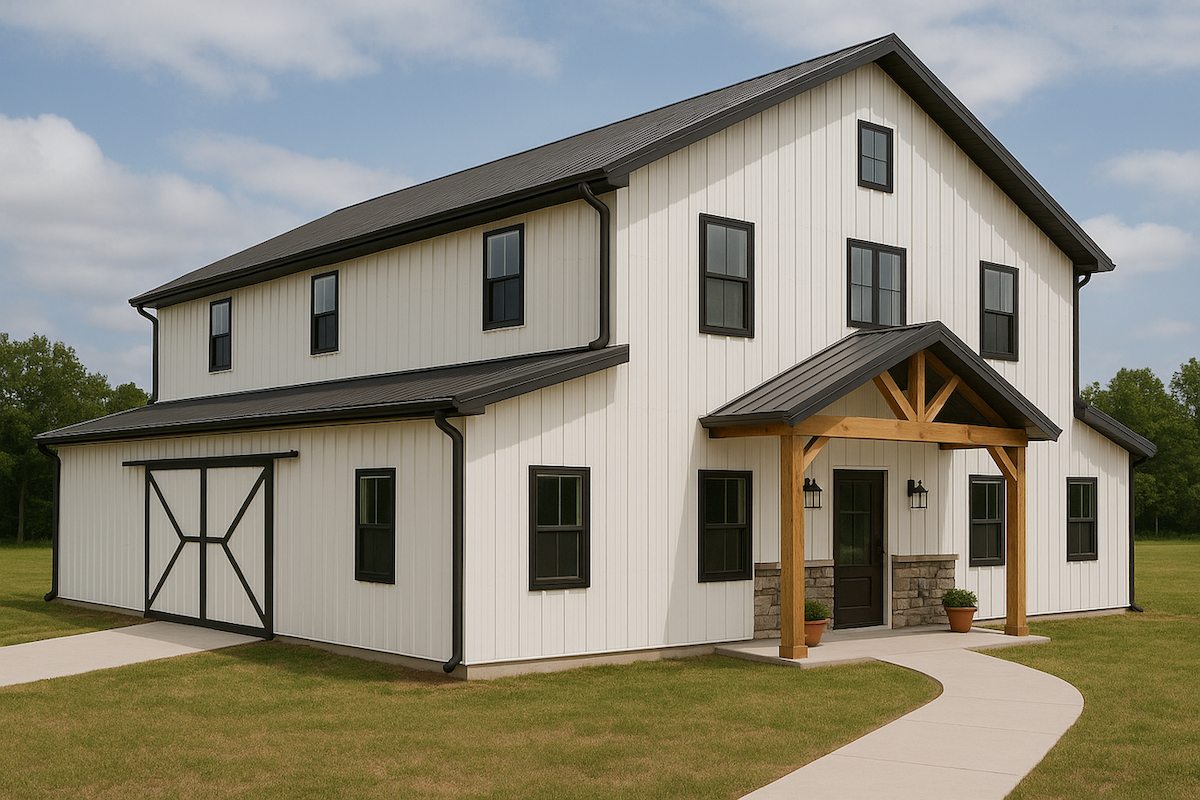Barndominiums, often called “barndos,” are unique structures that combine the rustic charm of a barn with the comfort and functionality of a modern home. These hybrid buildings typically feature open floor plans, high ceilings, and durable metal construction, making them especially popular among those who want the feel of rural living without sacrificing contemporary amenities.
For homebuyers interested in barndominiums and looking for an affordable loan option, USDA home loans can be a powerful choice. Backed by the U.S. Department of Agriculture (USDA), these loans are designed to make homeownership more affordable in eligible rural and suburban communities. They offer benefits like zero down payment, competitive interest rates, and reduced mortgage insurance costs.

Can you purchase a barndominium with a USDA loan?
Yes, USDA loans can be used to finance the purchase of an existing barndominium as long as the property and borrower meet USDA eligibility requirements. You can also use a USDA loan to build a barndominium with a USDA construction loan.
Note: Neighbors Bank currently does not provide financing for new construction barndominium homes. However, you can apply for a USDA loan for an existing barndominium. Get started here →
Pros and Cons of Using a USDA Loan For a Barndominium
When considering financing a barndominium with a USDA loan, weighing the pros and cons of this unique property type is helpful:
| Pros | Cons |
|---|---|
| Zero Down Payment | USDA Income Restrictions |
| Rural Locations Advantage | Difficulty Finding a Barndominium on the Market |
| Competitive Interest Rates and Reduced Mortgage Insurance Costs | Limited Construction Financing Options |
The Advantages
Zero Down Payment: USDA loans require no down payment, freeing up more money to cover other closing costs and moving expenses.
Rural Location Advantage: Considering the typical uses and nature of barndominiums, these properties are often purposely located in rural areas, making it relatively straightforward for potential buyers to find a barndominium that satisfies the USDA’s rural property requirement.
Competitive Interest Rates and Reduced Mortgage Insurance Costs: Because these loans are government-backed, they usually have lower interest rates than conventional mortgages. USDA loans also have a 1% upfront and 0.35% annual guarantee fee, lower than typical mortgage insurance rates.
The Disadvantages
USDA Income Restrictions: USDA loans have household income limits, which vary by location and family size. If your total household income exceeds 115% of your area's median income, you won’t qualify.
Difficulty Finding a Barndominium on the Market: Barndominiums are a niche home type, so finding one already built and USDA-eligible can be difficult. Inventory is often limited, especially in areas where barndos are less common or areas with restrictive zoning and building codes. This can make the home search longer and more competitive.
Limited Construction Financing Options: While the USDA offers a construction-to-permanent loan, not all lenders provide this option, and some may not finance non-traditional home types like barndominiums at all.
How to Buy a Barndominium with a USDA Loan
To qualify for USDA financing for a barndominium, make sure to follow these steps:
1. Find an Eligible Property
Like all properties financed by USDA loans, the home you purchase must be located in a designated rural area as defined by the U.S. Department of Agriculture. These areas typically include open countryside and small towns, but some suburban neighborhoods may also qualify depending on population size and density.
You can verify eligibility by entering an address into our online property eligibility map.
2. Be Within USDA Income Limits
In an effort to reserve this benefit for borrowers with low to moderate income, the USDA places caps on the amount a household can make within a year.
The USDA sets income eligibility at 115% of an area's median household income (AMI), adjusted for household size using HUD factors.
For most U.S. areas, the 2025 maximum income limits are:
$119,850 for households of 1–4 people
$158,250 for households of 5–8 people
These are baseline caps, and actual limits may vary—some lower-cost rural counties have significantly lower caps. You can use our income limit tool to find your area’s USDA limit.
3. Ensure the Home Meets Minimum Property Requirements
Outside of location restrictions, the property must also meet the USDA minimum property requirements (MPRs). Overall, these requirements ensure that a home is structurally safe, sound, and all major systems work properly.
Minimum property requirements include:
The home must be structurally sound with no major defects.
Electrical, plumbing, heating, and cooling systems must work properly.
The roof must be in good condition with no leaks.
The property must have safe access via a public or all-weather private road.
The home must have a safe water supply and a properly functioning waste system.
MPRs are evaluated during the home appraisal process, which also ensures that the home’s value matches its listing price.
4. Follow USDA Occupancy Requirements
USDA loans have strict occupancy requirements to ensure the property serves as the borrower's primary residence. This means the borrower must occupy the home within a reasonable time after closing (typically 60 days), and it must remain their main home.
USDA loans cannot be used for investment properties, vacation homes, or rental income purposes. The intent is to support rural homeownership for low- to moderate-income families, so borrowers must genuinely plan to live in the home full-time.
5. Meet Additional USDA Loan Qualifications
Aside from the barndominium property, the prospective borrower must also meet USDA qualifications and illustrate an ability to repay their loan. Generally, applicants must satisfy the following criteria:
U.S. citizen or permanent resident alien
620+ credit score (a common lender requirement, though it varies)
Maximum DTI ratio of 41% (although there may be circumstances where higher limits are permitted)
Stable income and employment for the past two years
No history of bankruptcy or foreclosure in the past 3 years
How to Build a Barndominium with a USDA Loan
Opting for a USDA construction loan allows borrowers to fund the construction of a new barndominium in a USDA-eligible location. Keep in mind, the borrower and property must still satisfy the same eligibility criteria as those for purchasing an existing barndominium with a USDA loan.
A significant advantage of USDA construction loans is that they are single-close mortgages. Many other construction loans require two separate lending processes: one where the borrower receives the construction loan, followed by another where the construction loan refinances into a traditional mortgage.
USDA construction loans, on the other hand, transition seamlessly into a 30-year USDA mortgage, so USDA borrowers only undergo the lending process once, allowing them to streamline their home financing process.
Bottom Line
USDA loans can be a smart financing option for eligible buyers interested in the unique charm and functionality of a barndominium—especially in rural areas where these properties are more common. With benefits like zero down payment, competitive rates, and reduced mortgage insurance, USDA loans offer significant affordability. However, buyers should be aware of potential limitations, including income restrictions, property eligibility rules, and limited availability of barndominiums on the market. If you find a USDA-eligible barndo that meets the guidelines, this loan program can be an excellent path to rural homeownership with modern flair.

